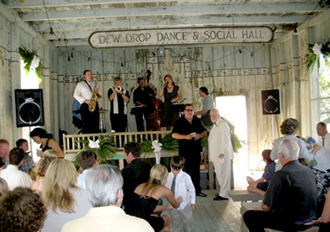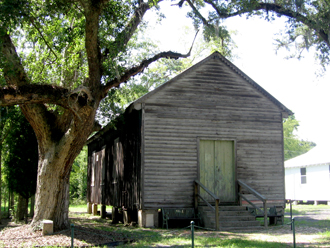Historic Jazz Hall Targeted for Preservation
The Tulane Regional Urban Design Center and the City of Mandeville have received a $20,000 grant from the National Endowment for the Arts to develop plans for the preservation of one of the nation's oldest unaltered rural jazz halls, the Dew Drop Jazz Hall in Mandeville, La. The city is matching the grant and also has provided an additional $150,000.

The humble Dew Drop Jazz Hall in Mandeville, La., once spotlighted performers such as Louis Armstrong. The Tulane Regional Urban Design Center is working with the city to preserve one of the nation's oldest, unaltered rural jazz halls. (Photo by Zella Walker)
Performers at the hall included Louis Armstrong, Buddy Petit and the Fritz Brothers. When the wooden hall was first built on Lamarque Street in 1895, performers had to cross Lake Pontchartrain by steamboat from New Orleans to reach it.
The hall's use, which included meetings and events planned by the Dew Drop Social and Benevolent Organization, peaked in the 1920s and '30s. By the mid-1940s it had closed and passed into private possession.
“The facility is the oldest rural jazz hall in the world,” says Grover Mouton III, director of the Tulane Regional Urban Design Center and adjunct assistant professor of architecture.
Mouton and colleague Nick Jenisch began conducting public meetings to gather ideas about the future of the hall in mid-July. Mouton's team includes Robert Bracken, who is completing his master's degree in preservation architecture at Tulane.
“Everyone loves this project,” says Bracken of the public response. “We just want to make sure that whatever we do with this is responsible and respectful.”

Preservation planning is under way for the Dew Drop Jazz Hall, which has a unique role in the history of the African American community in Mandeville, La., on the north shore of Lake Pontchartrain. (Photo by Madeline Vann)
The hall, which played a unique role in the history of the African American community in Mandeville, has not been used as a regular music or meeting venue for nearly half a century.
In recent years, the city and the non-profit organization Friends of the Dew Drop created a lecture and entertainment series to help raise money and awareness for the building. The challenge, says Jenisch, is to maintain the hall, create a unique music venue and visually highlight the history of the establishment.
“Ultimately they'd like people to experience the building but be sitting in a newer structure. We are at day one of a neighborhood study,” Jenisch says. Final plans will be presented to the city in a year.
Planners hope to use the hall and its history to extend the musical education of area high school students. The site extends back from the street, allowing for the possibility of another building and kiosks offering a historical narrative. The unpainted hall seats about 100 people, according to Jenisch, and it is not wired for electricity.
“When you are playing turn-of-the-century jazz, you don't really need amplification,” says Jenisch.
Madeline Vann is a freelance writer who holds a master of public health degree from Tulane.
